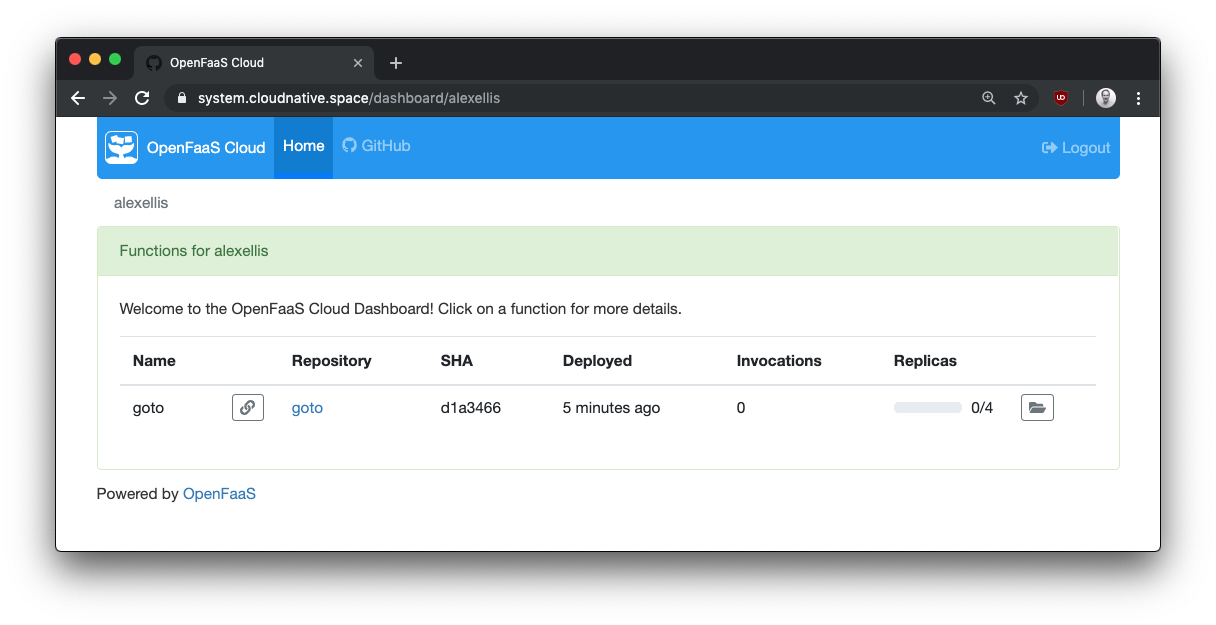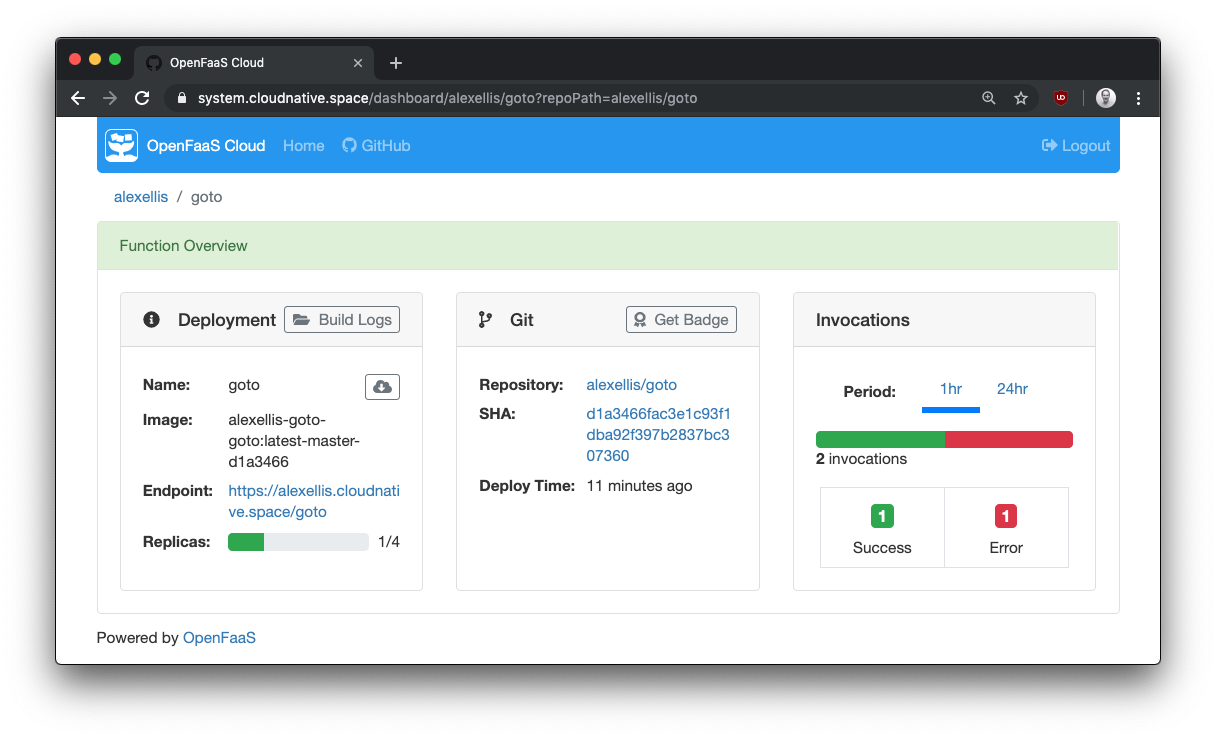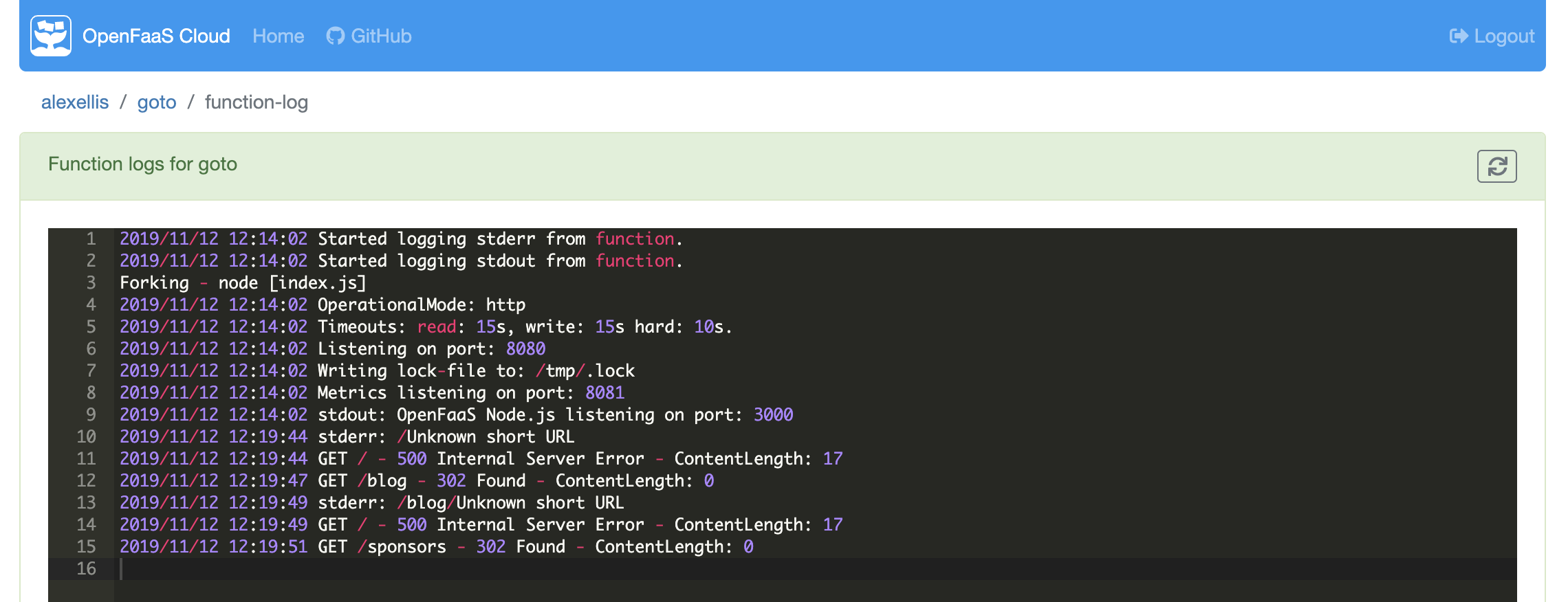OpenFaaS Cloud is a complete and portable platform which can be deployed to Kubernetes. It offers built-in CI/CD (GitOps), auto-scaling compute, and free TLS. OpenFaaS Cloud can be installed to any local or remote, managed Kubernetes cluster.
A production-ready installation on Amazon's managed Kubernetes service (EKS) may take a first-timer several hours to configure properly, especially if they get something wrong.
I wrote this guide to reduce the learning curve and "mean-time-to-dopamine", so you don't need to feel like you're in deep waters or re-creating expensive cloud infrastructure.
This guide is for development and shows how you can deploy OpenFaaS Cloud for in a relatively short period of time by turning off OAuth and TLS. The OpenFaaS deployment still retains authentication by default and you don't have to worry about being rate-limited by LetsEncrypt if you get things wrong.
Updates:
(3rd March 2020) to cover the new overrides files and
ofc-bootstrap create-github-appfunctionality
(1st Dec 2020) cover new k3d syntax and add domain deletion step
Tutorial
You'll need Docker if you don't have it already and a Docker Hub account. Once that's ready, you'll setup Kubernetes using k3d (it takes 1-2 mins), install the inlets-operator to provide a public IP, setup the GitHub app, create an init.yaml file and finally run the tool.

Pictured: ofc-bootstrap bundles a number of tools to deploy OpenFaaS Cloud with a known-configuration.
Get Docker locally
You should use a Mac, a Linux machine or a Windows computer with Git bash. Although OpenFaaS supports Raspberry Pi, OpenFaaS Cloud does not at this time.
-
Install Docker for Mac/Windows or Linux.
-
Install k3d
k3d runs Kubernetes with k3s within a tiny Docker container, which makes it portable and fast. If you've not tried it, then I think that you really should.
curl -s https://raw.githubusercontent.com/rancher/k3d/master/install.sh | bash -
Create a cluster
k3d cluster create \ --k3s-server-arg "--no-deploy=traefik" \ --k3s-server-arg "--no-deploy=servicelb"
k3s ships with Traefik, but ofc-bootstrap installs nginx-ingress instead, therefore we need to disable traefik with an additional flag.
k3d will now switch your kubeconfig and context to point at the new cluster, to check run: kubectl config get-contexts, you should see: *k3d-k3s-default
Install the inlets-operator
The inlets-operator will give you a public IP so that GitHub can contact your cluster for CI/CD. GitHub will send an event when repositories are added/removed and when there is a push event for a repo.
The Operator obtains a public IP for you by creating a low-cost VM on a cloud such as DigitalOcean or Equinix Metal (Packet).
The VM on DigitalOcean will cost you around 5 USD / mo, which is cheaper than an ALB, but will work from under almost any network conditions.
-
Create an API key on your DigitalOcean account
Save it as
~/Downloads/do-access-token -
Install the operator
arkade is a CLI tool that can install helm charts with easy flags, we'll use it to install the operator
curl -sSLf https://dl.get-arkade.dev | sudo sh arkade install inlets-operator \ --token-file=$HOME/Downloads/do-access-token
This uses the open source of inlets, if you wish, you can also use inlets PRO and have automatic encryption and working TLS certificates with cert-manager.
Register your domain name
You will need a domain name to setup OFC, even for development. You cannot edit your /etc/hosts file since GitHub needs to send you webhooks.
You can buy a .dev domain from Google Domains or go cheap with something more exotic from Namecheap.com where a .xyz or .space will only set you back a few dollars.
If you registered example.com, then we'll use a sub-domain for convenience.
Later when you have a public IP from this tutorial, you'll create these DNS entries:
system.k3d.example.com*.k3d.example.com
If you cannot create a wildcard domain for the second entry, then create a domain for each user or GitHub org that you will deploy from. i.e. if your name is alexellis then create alexellis.k3d.example.com
You don't have to include the sub-domain of .k3d., but I've done so for convenience and to separate this from any production clusters I may run on the same domain.
Prepare to run the ofc-bootstrap tool
-
Clone the repo
git clone https://github.com/openfaas-incubator/ofc-bootstrap cd ofc-bootstrap -
Now install the
ofc-bootstrapbinary or download it from the repo's releases page:curl -sLfS https://raw.githubusercontent.com/openfaas/ofc-bootstrap/master/get.sh | sudo sh -
Setup your GitHub App with
ofc-bootstrap create-github-appReplace
https://withhttp://wherever you see it.export DOMAIN="ofc.example.com" export GH_APP_NAME="Our Team OFC" ofc-bootstrap create-github-app \ --name "$GH_APP_NAME" \ --root-domain $DOMAIN \ --insecure
The
--insecureflag sets the various URLs to usehttp://instead ofhttps://
Example of what you get when using the GitHub App generator:

Save the results of the command to a file named init.yaml
-
Or create the GitHub App manually
Follow these instructions and ignore the steps for the OAuth app which are not using today.
Enter a webhook secret on GitHub on the screen and update
init.yamlwith the value in thegithub-webhook-secretsecret. If you used the generator, then it will tell you what value to save forgithub-webhook-secretin the final step.If you create the app manually, create a new
init.yamlfile and copy the parts you want to override fromexample.init.yamlinto it.
Edit init.yaml
For each setting you want to override, copy this from the example.init.yaml file.
cp example.init.yaml init.yaml
For example to set the root_domain and app_id, you would add these lines:
init.yaml
root_domain: example.com
app_id: example-value
To override a secret, just add a new item to the array of secrets created by ofc-bootstrap create-github-app.
- Set your domain in the
root_domainfield i.e.k3d.example.com - Set the GitHub App ID in the
app_idfield - Set the path to your GitHub private key
- Set the value for your
registry, use your Docker Hub account - Check your
~/.docker/config.jsonfile and make sure that it's base64-encoded, it will not work if your password is stored in the keychain. If in doubt, see the extended instructions in the README
Deploy OpenFaaS cloud
Run the tool in the folder you cloned:
# Make helm available in the $PATH
export $PATH=$PATH:$HOME/.arkade/bin/
ofc-bootstrap apply -f example.init.yaml -f init.yaml
We can specify any number of YAML files with -f filename.yaml. Here we use the example file and our own init.yaml file with our overrides.
Why use two files? This means that you only need to keep track of what you've changed, making merges and updates easier over time.
Note: when I ran this at home it took < 100 seconds and was up and running. If you're connected to hotel WiFi or low-speed broadband then it could take longer.
Find your public IP
kubectl get svc
Find the public IP for Nginx and create your DNS A records:
You can use two static entries:
system.k3d.example.comusername.k3d.example.com
If you're using DigitalOcean, then you could create these entries via the CLI:
export IP="public-ip"
doctl compute domain create --ip-address $IP system.k3d.example.com
doctl compute domain create --ip-address $IP alexellis.k3d.example.com
Or create a wildcard A record, which you can create through your DNS control panel. I couldn't find a way to create a wildcard entry via the doctl CLI.
*.k3d.example.com
Deploy a function
OpenFaaS Cloud is configured to build from a single named branch by default. So for new GitHub repos: you may need to update your branch to master from the new default of main.
Your functions YAML file must be called stack.yml so rename that if necessary.
- Go to the settings for your GitHub App and click "Install App"
- Install it onto a repo or your whole account
- Now trigger a build by doing a commit
The function will appear on:
http://system.k3d.example.com/dashboard/username
View your function on the dashboard a few seconds after hitting "git push"

Get function details and metrics

Or view the logs of the function at runtime:

You can now follow the User guide for OpenFaaS Cloud where you will deploy a function using Node.js.
Did anything go wrong?
The first port of call should be to try the steps in the Troubleshooting guide
Tear-down
k3d is very light-weight and you don't have to tear it down at all, you can keep everything running or run k3d cluster stop. The tunnel will retain its public IP address and everything will reconnect next time you re-start k3d or Docker.
Here's OpenFaaS Cloud which I installed using k3d earlier at home, reconnecting at a coffee shop through public WiFi.
inlets-operator brings a Service LoadBalancer with public IP to any Kubernetes cluster i.e. minikube/k3d/KinD/kubeadm
— Alex Ellis (@alexellisuk) October 18, 2019
I set up @openfaascloud on my laptop at home, when I got to a coffee shop it reconnected with the same public IP from @digitalocean😱https://t.co/PanfWfMRlT pic.twitter.com/hHCeMRW7z2
If you really do want to tear things down, then just run the following:
# This causes the inlets-operator to delete the VM it created as an exit-server
kubectl delete svc --all
# This removes the k3d cluster
k3d cluster delete
The first command ensures that the inlets-operator removes the VM created for your public IP. The second deletes the k3d cluster.
If you created DNS records, you should delete those too.
Wrapping up
Since we turned off TLS and OAuth, the time to get OpenFaaS Cloud running in this way should be just a few minutes. Adding TLS and OAuth can take additional time due to the learning curve about how certificates and DNS works. OAuth can add additional time to setting up due to configuration in GitHub.
This configuration is suitable for testing and development. The inlets-operatorinlets-operator gave us a tunnel so that we could expose the site to other users and to GitHub in order to receive webhooks.
You can get help with OpenFaaS Cloud from OpenFaaS Ltd or via OpenFaaS Community Slack
If you want to go to production with TLS and OAuth checkout one of these tutorials:
- Create your own private cloud with OpenFaaS Cloud
- Build your own OpenFaaS Cloud with AWS EKS
- Introducing OpenFaaS Cloud with GitLab
See also: